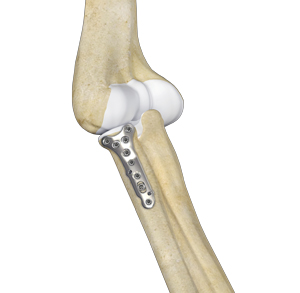
What is Radial Head ORIF and Replacement?
Open reduction and internal fixation (ORIF) of the radial head is a surgical technique employed for the treatment of a radial head fracture to restore normal anatomy and improve range of motion and function.
While conservative methods of immobilization or surgical fixation with screws can effectively treat minor fractures, more severe fractures and dislocation of the elbow joint may require removal of the radial head and replacement with a prosthesis. This is known as a radial head replacement.
Anatomy
The elbow joint is formed by the junction of the humerus (upper arm bone), and radius and ulna (forearm bones). The radius is the shorter of the two forearm bones and can be divided into the head, neck, and shaft. The radial head articulates with the humerus and ulna to form the elbow joint. Fractures of the radius frequently occur in the part of the bone closest to the elbow, called the radial head.
Indications for Radial Head ORIF and Replacement
General indications for radial head open reduction and internal fixation include:
- Large articular surface fragments
- Displaced radial head fractures
- Severe fractures or ligament injuries
- Bone displacement of greater than 2 mm
- Mechanical obstruction to forearm rotation
General indications for replacement of the radial head include:
- Fixation with plates or screws is not feasible
- When removal of the radial head causes elbow instability
- Arthritis
- Wear and tear
- Severe injury or fracture
Procedure for Radial Head ORIF and Replacement
Open reduction and internal fixation of the radial head is most often employed to treat displaced radial head fractures.
The surgery is performed under sterile conditions in the operating room under general anesthesia. After sterilizing the affected area, your surgeon will make an incision on the outside of the elbow. Your surgeon will locate the fracture by carefully sliding in between the muscles of the forearm. The fracture site is identified and cleaned out. After carefully visualizing the fracture, the bone fragments are repositioned (reduced) into their normal alignment. The fragments of bone are then held in place with wires, screws, pins, or metal plates attached to the outer surface of the bone. After securing the bone, the incisions are closed and a sterile dressing is applied.
To perform a radial head replacement, your doctor makes an incision at the outside of the elbow. All the fragments of the broken bone are carefully removed without injuring the surrounding tissues. Your surgeon determines the correct size of the prosthesis to facilitate a perfect fit. The radial neck is trimmed to receive the prosthesis. The central cavity of the radial shaft just below the radial neck is prepared with an awl. Your surgeon then inserts the chosen prosthesis and checks for stability and tracking during various movements of the arm. The incision is closed and a sterile dressing is applied. You may also be placed in a splint to protect the elbow.
Postoperative Care
Postoperative instructions and care for the management of ORIF or replacement include:
- Use of a sling or splint to immobilize the bone and allow healing
- Limited weight-bearing activities
- Dressing, bandage, and bathing care
- Physical therapy and exercise regimen
- Adherence to follow-up appointments
- Follow activity restrictions
Risks and Complications of Radial Head ORIF and Replacement
As with any surgery, some of the potential risks and complications of open reduction and internal fixation and radial head replacement may include:
- Bleeding
- Swelling
- Infection
- Pain
- Anesthetic complications
- Damage to nerves and blood vessels
- Hardware irritation
- Fracture nonunion
- Repeat surgery
- Broken bone around the implant
- Stiffness or instability of the joint
- Prosthetic failure
Related Topics
- Open Elbow Surgery
- Distal Biceps Repair
- ORIF of the Humerus Fractures
- Radial Head ORIF and Replacement
- Common Extensor Tendon Origin Repair
- Total Elbow Replacement
- Elbow Arthroscopy
- ORIF of the Coronoid Fractures
- Elbow Ligament Reconstruction
- Elbow Tendon and Ligament Repair
- UCL Reconstruction (Tommy John Surgery)
- Tennis Elbow Surgery
- Ulnar Nerve Release
- Ulnar Nerve Transposition
- ORIF of the Distal Humerus Fractures
- ORIF of the Olecranon Fractures
- Ulnar Collateral Ligament (UCL) Repair with Internal Brace





